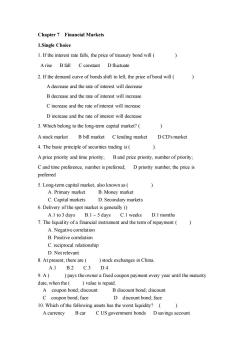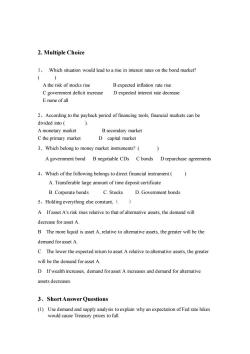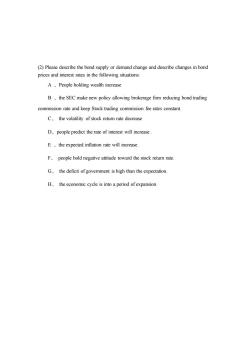同济大学:《货币金融学》课程教学资源(试卷习题)Chapter 7 Financial Markets

Chapter 7 Financial Markets 1.Single Choice 1.If the interest rate falls,the price of treasury bond will A rise B fall C constant D fluctuate 2.If the demand curve of bonds shift to left,the price of bond will A decrease and the rate of interest will decrease B decrease and the rate of interest will increase C increase and the rate of interest will increase D increase and the rate of interest will decrease 3.Which belong to the long-term capital market?( A stock market B bill market C lending market D CD's market 4.The basic principle of securities trading is( A price priority and time priority;B and price priority,number of priority; C and time preference,number is preferred;D priority number,the price is preferred 5.Long-term capital market,also known as( A.Primary market B.Money market C.Capital markets D.Secondary markets 6.Delivery of the spot market is generally A.1 to 3 days B.1~5 days C.1 weeks D.1 months 7.The liquidity of a financial instrument and the term of repayment A.Negative correlation B.Positive correlation C.reciprocal relationship D.Not relevant 8.At present,there are )stock exchanges in China. A.1B.2C.3D.4 9.A ()pays the owner a fixed coupon payment every year until the maturity date,when the ()value is repaid. A coupon bond;discount B discount bond;discount C coupon bond;face D discount bond;face 10.Which of the following assets has the worst liquidity? A currency B car C US government bonds Dsavings account
Chapter 7 Financial Markets 1.Single Choice 1. If the interest rate falls, the price of treasury bond will ( ) A rise B fall C constant D fluctuate 2. If the demand curve of bonds shift to left, the price of bond will ( ) A decrease and the rate of interest will decrease B decrease and the rate of interest will increase C increase and the rate of interest will increase D increase and the rate of interest will decrease 3. Which belong to the long-term capital market? ( ) A stock market B bill market C lending market D CD's market 4. The basic principle of securities trading is ( ). A price priority and time priority; B and price priority, number of priority; C and time preference, number is preferred; D priority number, the price is preferred 5. Long-term capital market, also known as ( ) A. Primary market B. Money market C. Capital markets D. Secondary markets 6. Delivery of the spot market is generally () A.1 to 3 days B.1 ~ 5 days C.1 weeks D.1 months 7. The liquidity of a financial instrument and the term of repayment ( ) A. Negative correlation B. Positive correlation C. reciprocal relationship D. Not relevant 8. At present, there are ( ) stock exchanges in China. A.1 B.2 C.3 D.4 9. A ( ) pays the owner a fixed coupon payment every year until the maturity date, when the ( ) value is repaid. A coupon bond; discount B discount bond; discount C coupon bond; face D discount bond; face 10. Which of the following assets has the worst liquidity? ( ) A currency B car C US government bonds D savings account

2.Multiple Choice 1,.Which situation would lead to a rise in interest rates on the bond market? () A the risk of stocks rise B expected inflation rate rise C government deficit increase D expected interest rate decrease E none of all 2.According to the payback period of financing tools,financial markets can be divided into ) A monetary market B secondary market C the primary market D capital market 3.Which belong to money market instruments?( A government bond B negotiable CDs C bonds D repurchase agreements 4.Which of the following belongs to direct financial instrument() A.Transferable large amount of time deposit certificate B.Corporate bonds C.Stocks D.Government bonds 5.Holding everything else constant,( A If asset A's risk rises relative to that of alternative assets,the demand will decrease for asset A B The more liquid is asset A,relative to alternative assets,the greater will be the demand for asset A. C The lower the expected return to asset A relative to alternative assets,the greater will be the demand for asset A. D If wealth increases,demand for asset A increases and demand for alternative assets decreases. 3.Short Answer Questions (1)Use demand and supply analysis to explain why an expectation of Fed rate hikes would cause Treasury prices to fall
2. Multiple Choice 1、 .Which situation would lead to a rise in interest rates on the bond market? ( ) A the risk of stocks rise B expected inflation rate rise C government deficit increase D expected interest rate decrease E none of all 2、According to the payback period of financing tools, financial markets can be divided into ( ). A monetary market B secondary market C the primary market D capital market 3、Which belong to money market instruments? ( ) A government bond B negotiable CDs C bonds D repurchase agreements 4、Which of the following belongs to direct financial instrument ( ) A. Transferable large amount of time deposit certificate B. Corporate bonds C. Stocks D. Government bonds 5、Holding everything else constant,( ) A If asset A's risk rises relative to that of alternative assets, the demand will decrease for asset A. B The more liquid is asset A, relative to alternative assets, the greater will be the demand for asset A. C The lower the expected return to asset A relative to alternative assets, the greater will be the demand for asset A. D If wealth increases, demand for asset A increases and demand for alternative assets decreases. 3、Short Answer Questions (1) Use demand and supply analysis to explain why an expectation of Fed rate hikes would cause Treasury prices to fall

(2)Please describe the bond supply or demand change and describe changes in bond prices and interest rates in the following situations: A People holding wealth increase B the SEC make new policy allowing brokerage firm reducing bond trading commission rate and keep Stock trading commission fee rates constant. C.the volatility of stock return rate decrease D.people predict the rate of interest will increase. E the expected inflation rate will increase. F people hold negative attitude toward the stock return rate. G the deficit of government is high than the expectation. H the economic cycle is into a period of expansion
(2) Please describe the bond supply or demand change and describe changes in bond prices and interest rates in the following situations: A 、People holding wealth increase B 、the SEC make new policy allowing brokerage firm reducing bond trading commission rate and keep Stock trading commission fee rates constant. C、 the volatility of stock return rate decrease D、people predict the rate of interest will increase . E 、the expected inflation rate will increase. F、 people hold negative attitude toward the stock return rate. G、 the deficit of government is high than the expectation. H、 the economic cycle is into a period of expansion
按次数下载不扣除下载券;
注册用户24小时内重复下载只扣除一次;
顺序:VIP每日次数-->可用次数-->下载券;
- 同济大学:《货币金融学》课程教学资源(试卷习题)Chapter 6 Central Banks.docx
- 同济大学:《货币金融学》课程教学资源(试卷习题)Chapter 5 Commercial Banks.docx
- 同济大学:《货币金融学》课程教学资源(试卷习题)Chapter 4 The Economics of Financial Intermediary.docx
- 同济大学:《货币金融学》课程教学资源(试卷习题)Chapter 3 Interest and Interest Rate.docx
- 同济大学:《货币金融学》课程教学资源(试卷习题)Chapter 2 Credit and Financial Instruments.docx
- 同济大学:《货币金融学》课程教学资源(试卷习题)Chapter 1 Money and Monetary System.docx
- 同济大学:《货币金融学》课程教学资源(大纲教案)教学大纲 The Economics of Money and Banking.pdf
- 吉林大学:《财政学》课程教学资源(试卷习题)远程教育考试样卷(无答案).doc
- 吉林大学:《经济法》课程电子教案(PPT教学课件,共十三章,授课对象:远程教育,授课教师:孙凤英).ppt
- 《财务管理》课程教学资源(专项报告)南宁市宾阳县生猪现代农业产业园实施方案(简版).pdf
- 《财务管理》课程教学资源(专项报告)存栏1120头商品猪养殖小区可行性研究报告(简版).pdf
- 《财务管理》课程教学资源(专项报告)存栏2000头祖代原种猪场可行性研究报告(简版).pdf
- 《财务管理》课程教学资源(专项报告)存栏3000头曾祖代原种猪场环保生态养殖综合开发项目可研报告(简版).pdf
- 《财务管理》课程教学资源(专项报告)存栏5000头基础母猪现代化生猪养殖场可行性研究报告(简版).pdf
- 《财务管理》课程教学资源(专项报告)山西灵空山国家级自然保护区2016年林业国家级自然保护区补助资金建设项目可行性研究报告(简版).pdf
- 《财务管理》课程教学资源(专项报告)森林康养度假建设项目可行性研究报告(简版).pdf
- 山西农业大学:《财务管理》课程教学资源(试卷习题)财务管理期末考试模拟题三及答案.pdf
- 山西农业大学:《财务管理》课程教学资源(试卷习题)财务管理期末考试模拟题二及答案.pdf
- 山西农业大学:《财务管理》课程教学资源(试卷习题)财务管理期末考试模拟题一及答案.pdf
- 山西农业大学:《财务管理》课程教学资源(试卷习题)第八章 利润分配管理(含答案).pdf
- 同济大学:《货币金融学》课程教学资源(试卷习题)Chapter 8 Money Supply and Money Demand.docx
- 同济大学:《货币金融学》课程教学资源(试卷习题)Chapter 9 Money and Inflation.docx
- 同济大学:《货币金融学》课程教学资源(试卷习题)Answers for Test Sample(参考答案)Chapter 1-10.docx
- 同济大学:《货币金融学》课程电子教案(课件讲稿)Chapter 1 Introduction(负责人:郭英).pdf
- 同济大学:《货币金融学》课程电子教案(课件讲稿)Chapter 2 Money and Monetary System.pdf
- 同济大学:《货币金融学》课程电子教案(课件讲稿)Chapter 3 Credit and Financial Instrument.pdf
- 同济大学:《货币金融学》课程电子教案(课件讲稿)Chapter 4 Interest and Interest Rate.pdf
- 同济大学:《货币金融学》课程电子教案(课件讲稿)Chapter 5 Financial Institutions.pdf
- 同济大学:《货币金融学》课程电子教案(课件讲稿)Chapter 6 Commercial Banks.pdf
- 同济大学:《货币金融学》课程电子教案(课件讲稿)Chapter 7 Central Banks.pdf
- 同济大学:《货币金融学》课程电子教案(课件讲稿)Chapter 8 Financial Markets.pdf
- 同济大学:《货币金融学》课程电子教案(课件讲稿)Chapter 10 Monetary Policy.pdf
- 同济大学:《货币金融学》课程电子教案(课件讲稿)Chapter 9 Money Demand and Money Supply.pdf
- 同济大学:《货币金融学》课程电子教案(课件讲稿)Chapter 11 Inflation and Deflation.pdf
- 吉林大学:《会计学》课程电子教案(PPT课件)第一章 绪论(负责人:孙烨).ppt
- 吉林大学:《会计学》课程电子教案(PPT课件)第二章 帐户与复式记帐.ppt
- 吉林大学:《会计学》课程电子教案(PPT课件)第三章 分录与记帐.ppt
- 吉林大学:《会计学》课程电子教案(PPT课件)第四章 试算与调整.ppt
- 吉林大学:《会计学》课程电子教案(PPT课件)第十章 无形资产与其他资产.ppt
- 吉林大学:《会计学》课程电子教案(PPT课件)第十一章 负债.ppt
